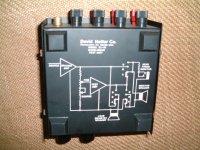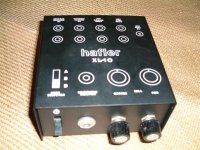This might have been true 40 years ago. In case it is measured on current designs, they must be extremely poor then. In fact, all the distortion products of a well designed amplifier lie 40dB or lower below distortion products of the good speaker. No problem to get absolutely negligible high order distortion from well engineered amp. No problems with small signals as well. There is no good amp with transfer curve like the No.2 with discontinuity like in your AES distortion paper, part II.
Yes, exactly.
Yes, human hearing is also non-linear.
More to my point, human cognition is nonlinear. It can matter a lot to humans how information is presented.
Yes, exactly.
Well, PMA and I have a disagreement as to whether his Toccata violin test files for an amplifier were audibly different. There was an extremely subtle difference that was repeatably discernible blind, but I don't think there is any way I could convince him of it.
I should point out that it is not just me that believe this, it is also professed by JBL's entire engineering staff and The THX people, just to name a few. I just happen to be the only one willing (or crazy enough) to come to the forums to express those beliefs.
And any results that are reported that are not blind can certainly not be held up as evidence against tests done correctly.
I'm going to take a shot at explaining what I think is going on here.
You make the claim that loudspeaker distortion is not an issue, then also report that
your systems do not have any distortion issues. You design speakers with 12" Pro
level woofers and horn tweeters, this is obviously overkill, then you add multiple sub
woofers. Distortion? you don't have any distortion, LOL.
I'm going to take a guess that you do not listen at "party" levels. You and Toole would
probably state that pushing a system into distortion is foolish therefore if you keep the
level down and therefore distortion is not an issue.
People, buyers in the marketplace, the "commoners" often use their systems for parties
where people enjoy turning it up more and more.
I test my systems at very high levels because I might someday want to market them to
"commoners", also I find the distortion characteristics/behavior interesting.
I enjoy studying value engineered designs because I believe that it is more of a challenge
than cost is no object designs. Take the EPI 100 for example it has a .75" long
voice coil and a .25" top plate for a calculated Xmax of .25". However, the back plate is
flat and not raised and therefore with slight overshoot the coil hits the backplate with a
loud crack. That is nasty distortion, you will probably call it destruction of the driver and
idiotic but people did encounter this limitation.
Genesis used the same or a copied driver in their Genesis II but they put a rubber bump
stop against the back plate. I was once at a party in my youth where Genesis IIs were
being played with the woofer VC obviously hitting the bumper. I nudged the bass down
until it stopped and the young lady hosting the party said we like it this way and turned it
back up. I said the woofer will fail, she said my brother works at the store where I bought
them and will get them fixed - LOL!
I have reverse engineered the Vandersteen 2Ci thinking that I might learn something and
have posted about it on the net over the last 15 years or so. A guy emailed me from CA
saying I had a party on the weekend and blew out every driver in my 2Ci's, I want the
boxes to go to good use. Do you want them? I said sure, he said I'll mail the boxes to
you no charge, LOL!
So, there is a grey area where a system is pushed hard, probably much harder than you
or Toole would, and then a level that causes damage. You and Toole probably stop at a
level that causes hearing damage, in fact your studies cannot go above this level due to
OSHA regulations. I think that this explains your and Toole's conclusion.
I've not blown a driver in my 2Ci's, in fact not since my teen years building speakers but
others will push a system to the limits.
Last edited:
Well, PMA and I have a disagreement as to whether his Toccata violin test files for an amplifier were audibly different. There was an extremely subtle difference that was repeatably discernible blind, but I don't think there is any way I could convince him of it.
Link to a description of the test and source files?
Link to a description of the test and source files?
http://www.diyaudio.com/forums/everything-else/314218-test-ears-abx-test-31.html#post5236617
Files to compare are in toc549.zip
...
Hafler did a null test years ago with their XL line of amplifiers that will uncover all forms of
distortion, are you familiar with that?
I've done level matched A/B tests of several excellent power amps and it is as if the
switch is not connected.
Hafler is not very good, I have one XL120 around as well as the null difference tester. If you look at the tester schematics, different loads are being driven thus effecting the result.
Hafler is not very good, I have one XL120 around as well as the null difference tester. If you look at the tester schematics, different loads are being driven thus effecting the result.
So design a better one, but the concept has been around for a very long time.
What specifically are the loads that you are referring to?
http://www.diyaudio.com/forums/everything-else/314218-test-ears-abx-test-31.html#post5236617
Files to compare are in toc549.zip
Interesting, but it involves crossover distortion and I said earlier that this type of distortion
is the nasty one that amp designers have known for decades is much more audible. At the
low levels in that test it probably IS inaudible. But even if it is that is his worst amp with
measurable crossover distortion - so what?
I said "good amps" sound the same.
Interesting, but it involves crossover distortion...
I said "good amps" sound the same.
I'm not sure all I heard could be accounted for by crossover distortion.
Anyway, some people can her undithered 16/44 audio. That's down pretty low.
As far as good amps, the one with the best measured specs I am aware of is this one:
Benchmark AHB2 Power Amplifier - Benchmark Media Systems, Inc.
People describe it as having a sound (or sounding a little different than other allegedly good amps they compare it to), but haven't tried one myself. (Afraid I might want to buy one if I do.)
Just by the distortion numbers, you might want to consider this.
Modulus-86: Composite amplifier achieving 0.000061 % THD.
Modulus-86: Composite amplifier achieving 0.000061 % THD.
You couldn't convince anyone of it, because you provided no evidence that it was repeatably discernible blind. Have you provided new evidence?There was an extremely subtle difference that was repeatably discernible blind, but I don't think there is any way I could convince him of it.
Pano, I asked Pavel what Foobar ABX scores he would accept, and I offered to provide him the exact scores he specified. He would not answer.
In addition, I wonder if you have read this: http://www.diyaudio.com/forums/digi...ble-difference-whatsoever-74.html#post5257549
Getting accurate results with ABX tests for very tiny differences, and the extreme concentration required do it perfectly many times in a row is something that requires training and practice like Olympic competition.
I said I could differentiate repeatably blind over multiple sittings, and if you doubt my honesty on that, then I don't know why you would trust any ABX result from me. I have already said that if I wanted to cheat with Foobar ABX it could be done very easily. Do you want to trust me or not? If not, then fine we are stuck right here.
In addition, I wonder if you have read this: http://www.diyaudio.com/forums/digi...ble-difference-whatsoever-74.html#post5257549
Getting accurate results with ABX tests for very tiny differences, and the extreme concentration required do it perfectly many times in a row is something that requires training and practice like Olympic competition.
I said I could differentiate repeatably blind over multiple sittings, and if you doubt my honesty on that, then I don't know why you would trust any ABX result from me. I have already said that if I wanted to cheat with Foobar ABX it could be done very easily. Do you want to trust me or not? If not, then fine we are stuck right here.
Last edited:
how does Fourier deal with a non linear function?
i lost sleep trying to figure that one out.
In a nonlinear system there are two series that one must consider. First is the Fourier series that defines any signal of a given base period to be definable by a series of harmonics. Second is what is called a Taylor series, a series in powers of say x like:
a0 + a1 * x + a2 * x^2 + a3 * x^3 + ...
The a's are called the coefficients, and x<= 1.0. In a linear system all coefficients except a1 are zero, i.e. it is a straight line, i.e. linear. In a nonlinear system the other a's will be nonzero. If you define x= sin(2*pi*f*t) and then square it and/or cube it, etc, you will find that new frequencies, i.e. harmonics occur. The set of a's define what is called the transfer characteristic which defines the non-linearilty of the system. (this is the simplest form and things can get more complicated.)
To answer some other (incorrect) claims (by some rude people) I have never said that all loudspeakers have inaudible distortion, that would be absurd. The claim is that a well designed loudspeaker has inaudible nonlinear distortion if operated within its design constraints. For example, if someone designs a loudspeaker to operate up to 100 dB and then plays it at 110 dB then my claim does not apply.
If you look at the Taylor series above you can see that it is only defined if x < 1.0, so the 1.0 becomes the design constraint, exceed it and all bets are off.
Hence any valid discussion of the audibility of nonlinear distortion has to include a statement about what is the maximum level that we are talking about and has it been exceeded.
My speakers can play at about 120 dB SPL(A) in my room without exceeding their maxSPL design limit. Now I never listen at this level, but I could. I do like loud music and when my son has parties here, as he often does (because the sound system is so good) they probably are at 110 dB +. Move these same speakers into an auditorium and they won't be able to come anywhere near 120 dB SPL(A) without going over their MaxSPL design limitation. So lets keep things sane here. We are talking about home listening at normal to loud levels, not auditoriums and boom boxes.
As far as amp distortion goes, I did define my test for nonlinearity below the noise floor here at DIY about a decade ago and I showed the results of my tests confirming that all amps were not alike in these tests. I did not publish this because I have not published anything in more than a decade - I'm just not interested in doing that.
Last edited:
- Home
- Loudspeakers
- Multi-Way
- Who makes the lowest distortion speaker drivers

